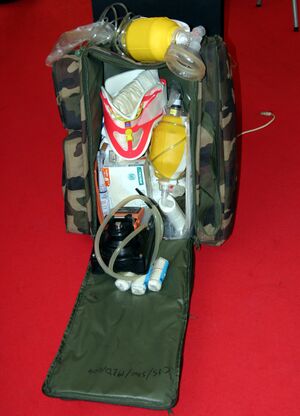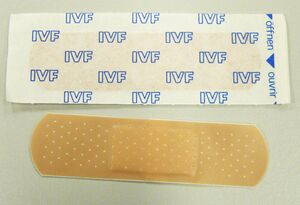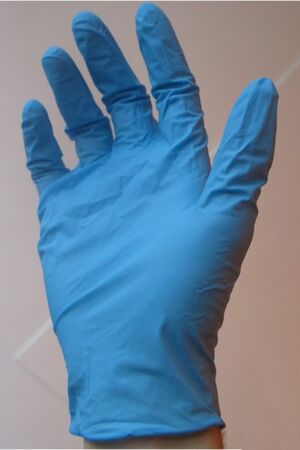First aid kit
A first aid kit is a collection of supplies and equipment for use in giving first aid, particularly in a medical emergency. Most first aid kits contain bandages for controlling bleeding, personal protective equipment such as gloves and a breathing barrier for performing rescue breathing and CPR (cardiopulmonary resuscitation), and sometimes instructions on how to perform first aid.
Placement
The American Red Cross recommends the standard contents of a first aid kit required in different situations (for example, in the US those set by the Occupational Safety and Health Administration and in the UK set by the Health and Safety Executive).
The host of any large gathering of people is responsible for responding to any potential medical emergency. This includes making sure that a responsible person has ready access to a first aid kit.
Schools keep a first aid kit in the main office, whether or not there is a designated nurse. Coaches and other athletic trainers should keep a first aid kit handy during sporting events.
Soldiers carry a rudimentary first aid kit attached to their belt or harness. It often contains a field dressing and powders or ointments to stop bleeding or prevent infection. It is a standard military practice that the soldier should always use the injured person's first aid kit, not their own, to tend to injuries. The soldier treating the wounds may be needing their own kit later.
Paramedics, EMTs and other prehospital emergency providers such as combat lifesavers usually carry a comprehensive first aid kit. Often called a "jump kit," this is a large duffel bag. Some of the supplies in a jump kit are beyond the skill of a typical first-aid provider, but common first-aid supplies are also carried.
Lifeguards must have quick access to a well-stocked first aid kit at their place of employment. In Canada, they are trained to the level of "Standard First Aid," and can deal with many first aid situations from a stubbed toe to a victim with C-spine injuries and absent vital signs. Obviously, a lifeguard is no replacement for a paramedic or doctor, but if you require care and a lifeguard is nearby, remember that they have training and a duty to act. Generally speaking, you may not use their first aid kit; they will have to provide care, and perhaps write a report per the regulations of the jurisdiction you are in.
Contents
Most store bought first aid kits, especially the cheap ones, are very poor in terms of quality, quantity, and selection of items, and are only suited for treating very minor injuries. A homemade kit, if properly prepared, is generally better and sometimes cheaper than most commercial kits.
A generic first aid kit is better than nothing. However, the contents of a first aid kit should be optimized for local conditions. For example, a kit for hikers in snake country should have a snakebite kit. A kit aboard a boat should have medications for seasickness.
One list of items for a first aid kit are as follows:
- Dressings (sterile, applied directly to wound)
- Pads
- Sterile eye pads
- Sterile gauze pads
- Sterile nonadherent pads
- Burn dressing (sterile pad soaked in a cooling gel)
- Occlussive dressing (airtight dressing, can be used to treat a 'sucking chest wound', in which air is sucked into the chest cavity, collapsing the lung (pneumothorax). For this use, occlussive dressings should be taped on 3 sides only, to create a 'one-way valve')
- petroleum gauze (also used as non-adherent dressing)
- Half of any gauze wrapper can be used, since the inside is sterile and air-tight
- Pads
- Bandages (sterility is not necessary, used to secure a dressing)
- Gauze Roller bandages - absorbent, breathable, and often elastic
- Elastic bandages - used for sprains, and pressure bandages
- Adhesive, elastic roller bandages - Very effective pressure bandages or durable, waterproof bandaging
- Triangular bandages - used as slings, tourniquets, to tie splints, and many other uses
Sometimes dressings and bandages are combined, in which case they must be sterile.
- Adhesive bandages (band-aids, sticking plasters)
- straight adhesive bandages
- Butterfly (knuckle) bandages
Instruments
- Adhesive tape, hypoallergenic
- Trauma Shears, for cutting clothing and general use
- Tweezers
- Irrigation syringe, for cleaning wounds
- Rubber suction bulb, for clearing the airway of an unconscious patient
- If treating snakebites is a concern. This is the only snakebite kit generally recognised as not causing further damage and possibly reducing the effects of a snakebite.[citation needed]
Equipment
- Splint(s)
- SAM Splint - Versatile splint made of malleable aluminum covered with foam
- Air splints - Easy to apply, can also help control bleeding, but bulkier and more expensive
- Wire ladder splint
- Personal Protective Equipment (PPE)
- Gloves, disposable non-latex
- CPR mask or other breathing barrier such as a face shield
- Eye cup or small plastic cup
- Flashlight (known as a torch in most Commonwealth nations)
- Instant-acting chemical cold packs
- Sterile eye wash (commonly saline)
- Sterile saline may also be used for cleaning wounds where clean tap water is not available.
- Swabs, sterile non-woven
- Space blanket (lightweight plastic foil blanket, sometmes called "emergency blanket")
- Hand Sanitizer or antiseptic hand wipes
- Thermometer
- Penlight
Medication (Single use packets of medications, ointments, and antiseptics will prolong shelf life, decrease contamination risk, reduce risk of leakage (usually), and save space (for small quantities). If large amounts of a medication are needed, a multi-use container can be used in addition, but keep single-use packets as a backup. For general household use (not in first aid kits), single use packets can be wasteful and bad for the environment.)
- Antiseptics/antimicrobial
- Povidone iodine wipes - very effective and painless, but messy. Can also be used to purify water
- Benzalkonium Chloride - painless, effective, often includes anesthetic. (Bactine is one brand.)
- Alcohol pads - should not be used on open cuts or wounds, since they cause tissue damage and delay healing. They can be used to prep unbroken skin for injections etc. or to disinfect equipment such as thermometers. While not a medical use, alcohol pads are also useful as a solvent to remove ink, adhesives, etc.
- Antibiotic ointment - single, double, or triple antibiotic ointment in petroleum jelly base (i.e. Neosporin, Polysporin). Since it has a petroleum jelly base, it can be used for things such as chapped lips.
- Antiseptic/anesthetic ointment or spray
- Anti-itch ointment (especially for outdoor kits)
- hydrocortisone cream
- antihistamine cream, such as benadryl
- calamine lotion
- Painkillers / fever reducers (since moderate fevers are beneficial, avoid unless necessary)
- Acetaminophen (brand name Tylenol)
- Ibuprofen (such as Advil) - anti-inflammatory, often more effective that acetaminophen
- Naproxen (such as Aleve) - similar to ibuprofen, but stronger and longer lasting
- Aspirin - one 300mg Aspirin tablet may be given to a patient suffering a heart attack, to be chewed slowly.
- Antihistamines - can treat allergies and allergic reactions, including life-threatening anaphylactic shock. Although OTC (over-the-counter) medications are far less effective at treating anaphylaxis than epinephrine or prescription drugs, they are much better than nothing and can be potentially life saving, and therefore may be the most valuable medication in a first aid kit.
- diphenhydramine (brand name Benadryl)
- Aloe vera gel - used for a wide variety of skin problems, including burns, sunburns, itching, and dry skin
- Burn gel - a water based gel that acts as a cooling agent and often includes a mild anesthetic such as lidocaine and, sometimes, an antiseptic such as Tea Tree Oil (Melaleuca Oil)
- Epinephrine auto-injector (brand name Epipen) - Often included in kits for wilderness use and in places like summer camps, to treat anaphylactic shock. Requires a prescription and can be used with minimal training.
- Poison treatments
- Activated charcoal - to be used when directed by poison control.
- Syrup of ipecac - to be used when directed by poison control.
- QuikClot is a hemostatic agent sometimes included in first aid kits, especially military kits, to control severe bleeding. It is recent product not yet widely marketed to civilians, although in 2002 Z-Medica (maker of QuikClot) received FDA clearance to do so.
Note that regulations in some jurisdictions prohibit the provision of actual medications in a workplace first aid kit. In addition, many first-aid organizations explicitly prohibit the use of medication by a non-medical professional due to the possibility of serious legal repercussions. (See Good Samaritan Law).
Improvised uses: Many first aid items can have improvised uses in a survival situation. For example, alcohol pads and petroleum jelly based ointments can be used as a fire-starting aid in an emergency, and the latter can even be used as an improvised lubricant for certain mechanical devices, and adhesive tapes and bandages can be used for repairs. These alternate uses can be an important consideration when picking items for a kit that may be used in wilderness or survival situations.
Improvisation
First aid can be performed without a first aid kit. Any cloth (preferably as clean as possible) can be used as a bandage. Duct tape could also be used to secure a dressing. Common household items such as a magazine or even sticks can be used for splints. Direct pressure to stop bleeding can be applied with a hand if nothing else presents itself. Obviously it is better to have proper equipment, but improvised equipment has saved many lives.
See also
- First aid
- Bug-out bag


